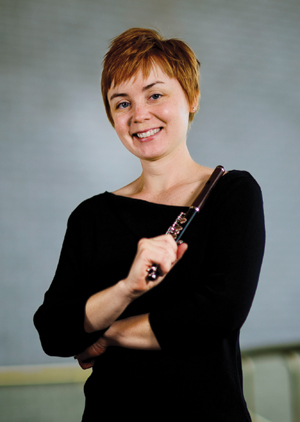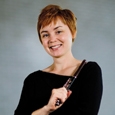 Caitlyn Valovick Moore joined the Utah Symphony as piccolo/flute in 2008. A native of northern Michigan, she is a graduate of the Interlochen Arts Academy, DePaul University (B.M., Mary Stolper, flute professor) and Northwestern University (M.M., Walfrid Kujala, flute professor) and has also studied with Stephanie Mortimore and performed in masterclasses for William Bennett. Before joining the Utah Symphony, she was a member of the Virginia Symphony Orchestra and the Civic Orchestra of Chicago. She also performs each summer with the Grand Teton Music Festival Orchestra. She has appeared as soloist with the Virginia Symphony Orchestra and won second prize in the National Flute Association’s 2004 Piccolo Artist Competition. In Salt Lake City, she has performed chamber music on both the Nova and Intermezzo chamber music series. In November 2016, she will perform the world premiere of Simon Holt’s piccolo concerto on the Nova series. Valovick Moore is an adjunct assistant professor at the University of Utah and presents masterclasses around the United States.
Caitlyn Valovick Moore joined the Utah Symphony as piccolo/flute in 2008. A native of northern Michigan, she is a graduate of the Interlochen Arts Academy, DePaul University (B.M., Mary Stolper, flute professor) and Northwestern University (M.M., Walfrid Kujala, flute professor) and has also studied with Stephanie Mortimore and performed in masterclasses for William Bennett. Before joining the Utah Symphony, she was a member of the Virginia Symphony Orchestra and the Civic Orchestra of Chicago. She also performs each summer with the Grand Teton Music Festival Orchestra. She has appeared as soloist with the Virginia Symphony Orchestra and won second prize in the National Flute Association’s 2004 Piccolo Artist Competition. In Salt Lake City, she has performed chamber music on both the Nova and Intermezzo chamber music series. In November 2016, she will perform the world premiere of Simon Holt’s piccolo concerto on the Nova series. Valovick Moore is an adjunct assistant professor at the University of Utah and presents masterclasses around the United States.
Where do you place your cork?
I have always left my cork where it has been placed by the manufacturer. It is placed so the line in the cleaning rod is in the middle of the embouchure hole.
How is headjoint aligned with the body?
I have the headjoint set so that the front edge of the embouchure hole is lined up with the front edge of the C key on the body. I find that this gives me a round, even tone, and allows flexibility when adjusting intonation.
Do you use one or two earplugs?
When I practice piccolo, I almost always wear earplugs in both ears. There are occasions when I do not use them, but only if I am playing something very soft and not too high. I have custom musician’s earplugs with two different filter levels, 15dB reduction and 25dB. I use the 25 in my right ear and 15 in my left. (This is a tip I picked up at a panel discussion at a NFA convention.) Musician earplugs are a bit of an investment, but I feel that it is absolutely worth it. They are the best option to reducing volume while still being able to hear the sound, or a close approximation to it. I practiced with foam earplugs before I got these, and I suggest that my students use some form of hearing protection when they practice. When I am at work, I wear plugs when I feel it is necessary. If we are playing a Pops concert, then I need the 25s because of the amplification. There are times, however, when I just use one for my right ear, if I do not have time to put both in.
What alternate fingerings do you use on a regular basis?
I do not use that many alternate fingerings, but I do use L23 R14 for a higher C# in Shostakovich 6 and L13 R23 for the high F# in that excerpt. There is a pp second octave C at the end of “Romeo at the Tomb of Juliet” from Prokofiev’s Romeo and Juliet Suite, and I use L123 R14 for that. It is quite sharp on my instrument, but I find it much easier to bring the pitch down a bit and hold it for four bars, rather than hope I can keep the pitch up. I also usually play the 3rd octave G# with R23 added.
How do you warm up?
I warm up by playing some chromatic long tones, descending from middle D, and then ascending a little from the same starting point. I also warm up on Taffanel et Gaubert #1 and usually some Reichert, quite often #1. I usually play a bit on flute before moving to piccolo, and my warm up may vary based on the repertoire for the week.
Do you have any tuning tricks when playing in an orchestra?
I think that the trick is to know your instrument’s tendency and work with a tuner, especially using a drone to practice different intervals. It is all about training the ear. You have to really listen across the orchestra and know who you are playing with (score study is important for this). Know what pitch the fixed pitch instruments are tuned to (celeste, keyboard percussion, harp, etc.) as it may vary from the tuning pitch of the group. Be flexible and willing to work on sections with your colleagues.
How does vibrato differ between the piccolo and the flute?
I feel that vibrato on piccolo is usually a bit more narrow and faster than on flute because of the higher range. The vibrato you would use on flute on a high B-flat is going to be faster than what you would typically play on a low C. I think a narrower vibration is better so the airstream does not get affected. With a smaller aperture, the air speed is faster and it cannot handle a wide fluctuation.
What are the top 5 or 10 excerpts a piccolo player should know well?
I think that the Piccolo Excerpt Book by Jack Wellbaum is indispensable to anyone interested in piccolo as well as Walfrid Kujala’s book Orchestra Techniques for Flute and Piccolo: An Audition Guide. Apart from that, I think that Shostakovich’s Symphony #6, Beethoven’s Symphony #9, Rossini’s Semiramide, Bartók’s Concerto for Orchestra, Ravel’s Mother Goose Suite and Daphnis et Chloe, Tchaikovsky’s Symphony #4, and Ippolitov-Ivanov’s Caucasian Sketches are all important to know.





